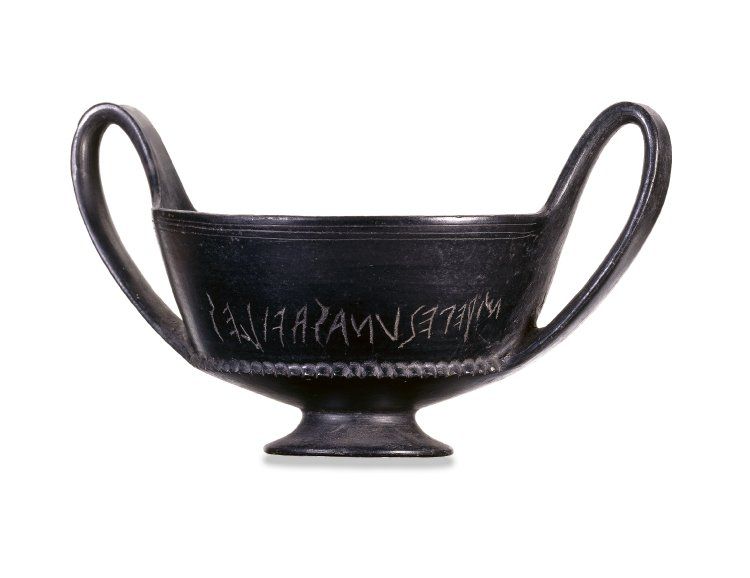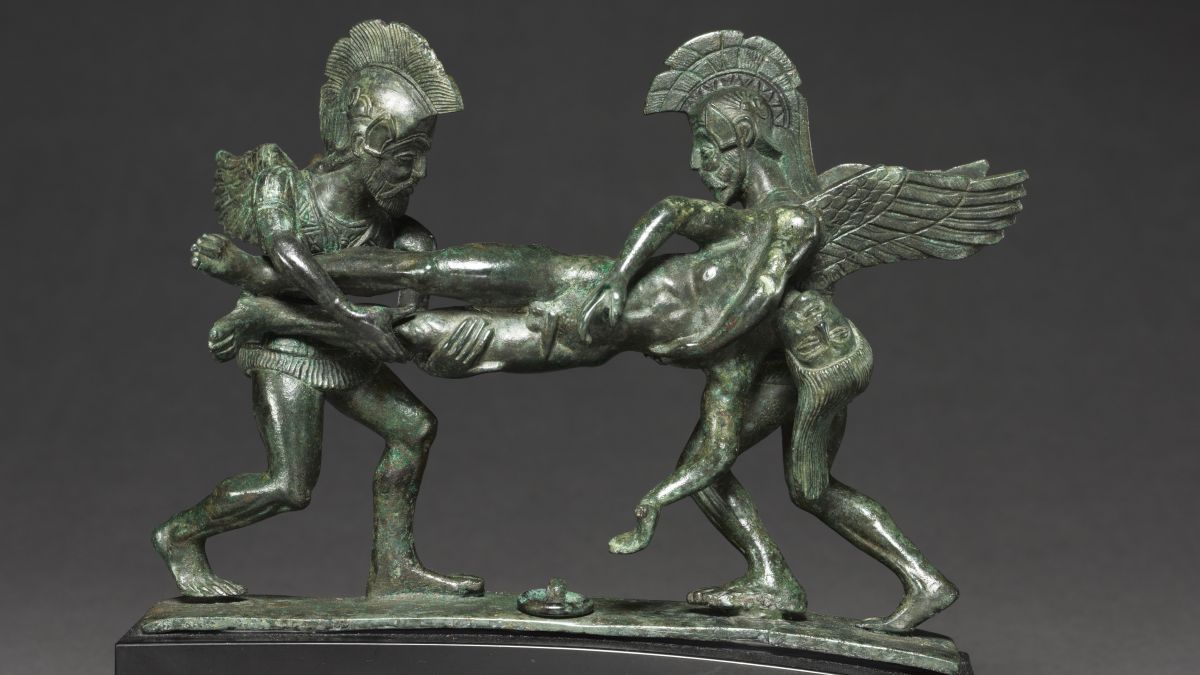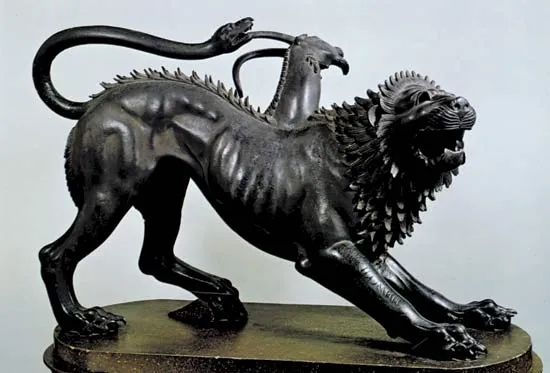The Legend of Rome Receives Her Rightful Addition: Etruscan Art, Story, and Language
by Aiden Wetterhan, Form V
12 min. read — May 19, 2023
The Legend of Rome Receives Her Rightful Addition: Etruscan Art, Story, and Language
2000 years after the lives of the great poets, orators, and conquerors of Rome, we can confidently say that it was Roman culture and language which acted as a mother to the Western tradition, nursing our modern-day culture in the very same way that the she-wolf did Romulus and Remus. Furthermore, the Latin language is assuredly the first and foremost language for understanding the Romance languages and even made its way into our own English tongue. However, a plethora of problems with this notion soon begins to make itself known. While the distributive power of the Roman empire and the vast retinue of thinkers it begot instill its place among the forerunners of the great patriarchs of the Western world, from whence did these traditions and language first come? You might swiftly harken to the Greeks or the Trojans. There is much to be conceded there, and although we do not recite the Iliad and the Odyssey annually like the Athenians did or ensure that students take Ancient Greek in our public schools, Greek mythology occupies an omnipresent domain in popular culture, the Ancient Greek language is still maintained among select groups, and the philosophies of the Ancient Greeks dominate the way we think about the religions of the modern world. Still, come now, if another founding role in modern Western society is conceded to the Greeks, alongside the Romans, is there still not another? Is there not at least one other great tradition that came before the Romans which is bursting at the seams for the advent of our more complete understanding, enjoyment, and reveling in our present day? Certe! Indeed, the culture and language you are looking for are that of the Etruscans. Though their language and culture were once as stone dead as their many necropolises which litter Italy, their language is beginning to be unraveled and their works of art along with those foretold have become the perpetual lure of swaths of historians, linguists, and artists. What is more, the Etruscans were nearly as important for the establishment of the Roman identity and language we have today as the Greeks were, acting as intermediaries in transmitting the Greek alphabet, artistic tradition, and language. However, they added further crucial changes to the Greek tradition, being chiefly responsible for making Greek language and cultural traditions those of Rome. Thus, the Etruscans have rightfully merited a position among the forefathers of our Western tradition, sculpting our form out of the very earthen clay they trod on.
Now, if the Etruscans have up until recently, and even, arguably, presently assumed the role of rara avis, shrouded in mystery and the cause of confusion of modern scholars, do they merit our further study as a society – do they merit your attention and devotion? The former seems to be solved simply, i.e., the greater the mystery around a language and a tradition, the greater the movement there will be for studying the civilization as long as a bone is rolled to scholars by Fortuna, and plenty of bones have been rolled their way, indeed. Of course, a catalyst for further investigation into the Etruscan people and their language will be the easy induction of pragmatic benefits from further investigation. Most often, this too is what might nurture one’s personal interest in the antiquities or a language. It appears, increasingly, that there are more benefits which can be reaped as a society and by the individual if one only prepares to learn the customs of the Etruscans. Already, many benefits have been enjoyed by scholars and those dedicated to learning the language. Why don’t we start from the beginning with the origins of the Etruscans themselves? Who knows, maybe in the process we will add one more culture to our small, selective entourage of those which are chiefly responsible for founding and enriching the Western tradition.
At first, there were two competing theories which attempted to explain the origins of the Etruscans. One theory, put forth by Herodotus, claimed that the Etruscans were migrants, descended from a group situated along the Aegean Sea, who had fled their homeland upon the outbreak of famine. The other theory, supplied by Dionysius of Halicarnassus, believed that the Etruscans were native to the Italic peninsula. Over the years, these theories have enjoyed varying degrees of consideration and promotion by certain scholars. However, the general consensus of historians remained mute as to which of these two theories was correct. It increasingly seems as if Dionysius’ theory was correct, until, just recently, genetic testing yielded strong support for an entirely different conclusion: the Etruscans, along with the Latins, had migrated during the Bronze Age from the Pontic-Caspian Steppe, which is situated just north of the Black Sea. One can begin to make out the inception of the complex and at times fickle relationship between the Etruscans and the Latins.
When the Etruscans arrived on the Italic peninsula, they inherited a land rich in metallic reserves, including copper. It was out of this copper that the Etruscans fashioned vast quantities of bronze sculpture. Many Etruscan cities were anointed with sculpture workshops and filled with brilliant artists, some of the talent hailing from as far away as Celtic regions. On account of the advantageous geography of the Italic peninsula, the Etruscans achieved the rank of a major trade power in the Mediterranean, interacting frequently with the Greeks, Phoenicians, Baltic states, and Egyptians, learning their renowned art techniques. Despite the support the Etruscans received from their geography which enabled them to produce vast quantities of breathtaking art, it is undeniable that the Etruscans honed skills of their own. Their bronze sculpture is arguably unmatched in the ancient world. This was the art that earned the awe of not only noteworthy figures in Roman history such as Pliny the Elder but also of the art world of Rome as their realist portraiture techniques drew heavily from the Etruscan’s own desire to render their subject’s unique countenance. Often Etruscan artwork had the signature Greek mark of contrapposto, but they came upon their own artistic tradition not by idealizing the human body like the Greeks, but rather by portraying the unique, human qualities of the figures depicted. However, it would be a mistake to think that the Etruscan art tradition was static or uniform. Rather, Etruscan art at times incorporated older and more rudimentary traditions to create works defined by abstractions which one may associate with the simplified forms of modern art. Furthermore, the Etruscans developed prowess in rendering figures into diverse media, including alabaster, marble, and nenfro, which is a type of tufa, or porous rock, employed by the Etruscans in their art and architecture. The Etruscan art period constitutes the collaboration for and expansion of various Mediterranean art traditions and remains, assuredly, the prizéd object of art enthusiasts when evaluating the trends and intercultural influence of artistic styles within the Ancient Mediterranean. Still, the art enthusiast can find significant value in Etruscan works as pertains to the vast repertoire of Western artistic traditions e.g., though sometimes differing in methodology, the Etruscan attempt to depict realist works which highlighted the individuality of the personage is reminiscent of the aspirations of Renaissance artists. From thence, a flurry of questions proceeds: What motivated the Etruscans to depict their subjects in a realistic manner? Did Renaissance sculptors end up re-inventing certain Etruscan techniques of rendering the individualistic characteristics of a person? Is the primary appeal to render images realistically across the Etruscan, Roman, and Renaissance traditions economic, interpersonal, or religious – what insights does this offer us about the values of these respective societies? Thus, food for thought is the crest which adorns every newly discovered Etruscan work of art. However, this is not the only thing which frequently adorns Etruscan art, as Etruscan alphabeti and compositions abound too; not only is this an opportunity for art historians to contextualize the works of the Etruscans, but it is also the kairos, rightful occasion, for art historians to hand over the mic to linguists.
From the oldest Etruscan alphabetum excavated, we know that the Etruscan alphabet, at first, nearly mirrored Ancient Greek. What is more, many Etruscan words were cognates for Greek words. While it would be rash to say that Etruscan was nearly another Greek dialect, it shared many commonalities with the dialects of the Greeks. The first proposal of the origins of the Etruscan language is almost as robust and perplexing as the early hypotheses of where the Etruscan people themselves came from. After wading through a particularly, putrid, lying Renaissance friar, 1800s and early 1900s Western European theorists, and ex-Soviet linguists, more and more scholars are beginning to lay aside a wide array of previously proposed etymologies for the Etruscan language and settle upon the Tyresian family hypothesis. Simply speaking, this means the Etruscan language descended from common Tyrrhenic, a non-Indo-European language which is also believed to have begotten the Rhaetic, Alpine tongue and one of the Greek tongues – Lemnian. If you happen to have never heard of these languages before, do not be dismayed! There is a minuscule amount of currently available texts from these languages. Hence, the Etruscan languages could be used to infer further information about the structure of the other Tyrrhenic languages, the existence of a common Tyrrehnic language, and the cultural traditions of each of these groups of people. Thus, Etruscan can serve as a gateway to understanding an elusive branch of non-Indo-European languages, and hopefully, to understanding the early interactions and language exchange which occurred between non-Indo-European and Indo-European language groups. Certainly, the alphabet and short inscriptions on pottery and sculpture alone are not enough to decode the language of the Etruscans and to draw conclusions about the other languages in the Tyrrhenic language family. Fortunately, these are not all the inscriptions which have been afforded by antiquity. Additionally, linguists have developed creative ways of performing more nuanced evaluations of the Etruscan language and some of their strange wording.
All in all, this work by Etruscan linguists has resulted in the development of great strides in understanding the vocabulary, morphology, and phonology, or pronunciation and intonation of the Etruscan language. To date, somewhere between 9,000 and 13,000 Etruscan inscriptions have been recovered. Among these, only a small percentage of this massive figure includes a substantial length of comprehensible Etruscan. Liber Linteus Zagradbiensis tops out at 1,200 words and is filled mostly with repetitive prayers. The Tabula Capuna is comprised of 300 words. Other works provide eye-opening insights into deities and names used among the Etruscans. When all else fails, linguists use indirect references to the Etruscan language by Roman authors to deduce the meaning of certain Etruscan words. Moreover, linguists make good use of the large number of Latin words with unknown etymologies; they hypothesize the existence of Etruscan words they have yet to even discover via surmising the existence of Etruscan cognates for the elusive Latin words. Now you must be dying to know what makes the Etruscan language so special such that it might be ranked with the great colossi of Latin and Ancient Greek. Where is their Iliad or Aeneid? Where are their great philosophers? Have they left an undeniably crucial mark on the English or Romance languages? While it would be unwise to predict the rediscovery of Etruscan texts which were lost to the rolling sun epochs ago, it is nevertheless proper to inform about the mighty seat which Etruscan one occupied on the tongues of many Romans and to discuss the works of antiquity which could someday be resurrected. The Romans loved Etruscan. It was their educated language of choice, prior to the adoption of Ancient Greek by the upper echelons of Roman society. Emperor Claudius adored the Etruscans so much that he was rumored to have written an anthology of the Etruscan language and their culture around the time of their diaspora during the early Roman Empire. If only we had a copy of this insightful catalog of the Etruscan people, we would be able to translate the great works in Etruscan with much greater ease. The aforementioned Liber Linteus Zagrabiensis is one such example of the great works produced by the Etruscans, and this work, which we do in fact have, mirrors some of the other longer Etruscan books. Also religious in nature and daring for the reader are the other libri (books) which comprise Etrusca Disciplina. Etrusca Disciplina offer a more direct, first-hand, glimpse into the beliefs and traditions of the Etruscan people, in that sense outdoing Claudius’ magnum opus. However, if Etrusca Disciplina is not to be discovered with an accompanying Latin version in the future, it would make understanding the contents of the work a Herculean labor. To that accord, the possibility remains that one of the many great theatrical works of the Etruscans could be uncovered first. In that case, the likely differing vocabulary of these theatrical works might act, prima facie, as an impediment to brisk translating and deciphering further information about the Etruscan language. Nevertheless, in the long term, assistance from similarities in the Latin and Greek theatrical traditions could lighten this particularly brutish burden, which in turn would leave linguists and aspiring Etruscan scholars with a much more diverse and bountiful vocabulary from which future deciphering of texts could be carried out with much greater ease. Truly, Etruscan is not like its Latin and Ancient Greek counterparts with respect to its undeniable young countenance adorned with a much smaller master vocabulary list and collection of Etruscan works.
I cannot deny these blatant difficulties with Etruscan, but perhaps, I can offer one last bit of information in the form of la grande contextualization. Is not there a unique affability about a language in waiting? Is not there a dot of joy, nourished by soothing information, which bubbles to the top of your being and fills you with ecstatic joy, knowing that new works of a lost civilization could be uncovered any day now? Is not there the spectacular illusion that one may enter an Etruscan necropolis, dine with the dead there, listen to them speak about their gods and the promises of old, remark upon the ghostly resemblance that a bronze statue has with your companion Arnthi, enjoy a fine theatrical performance with those interlocutors, all before turning to leave that fair city, and putting down the inscriptions before you? What I speak of here is when the Romantic visionary is joined at the hips with the Classics scholar. Together they seek to answer the question “cur?” Why do we care about making the most money? Why do we live in homes that look like this? Why do we go to the theater? Why do we invoke our gods this way? Why do we laugh here and mourn there and rise again the next day to repeat? These are the humanities, which evade the harms placed against the Romanticist, and the shades which, upon having their cover discovered, flee at once from the approach of the relentless Classicist who knows not of disciplines. So, formalized pursuits of Etruscan are not meant for everyone, and yet everyone can indulge for some time in the renown of Etruscan art, diction, and mythistoria, a fabulous narrative or tall tale.



